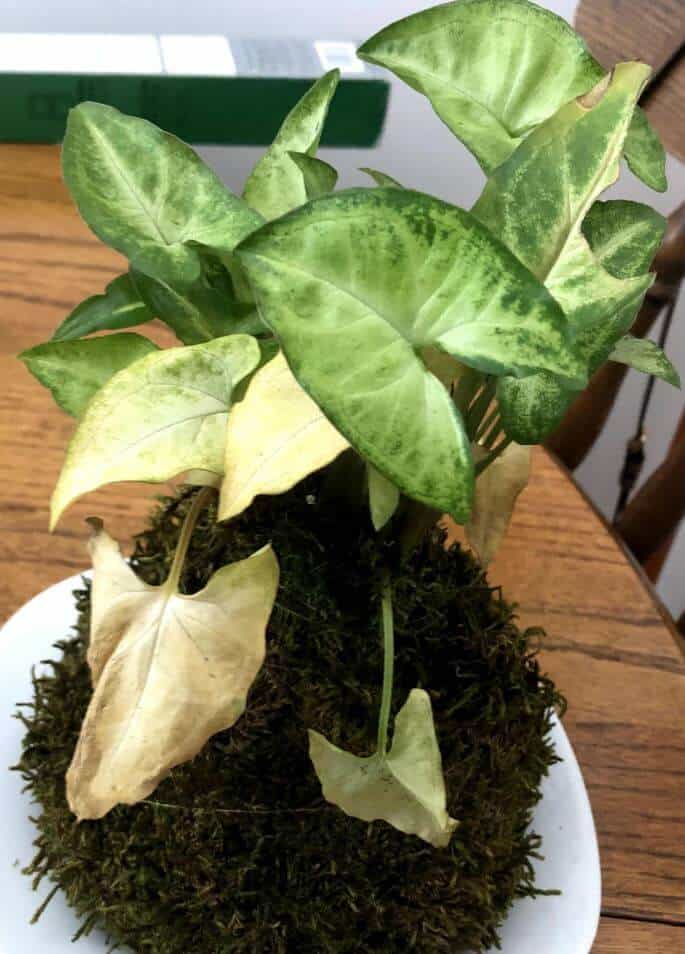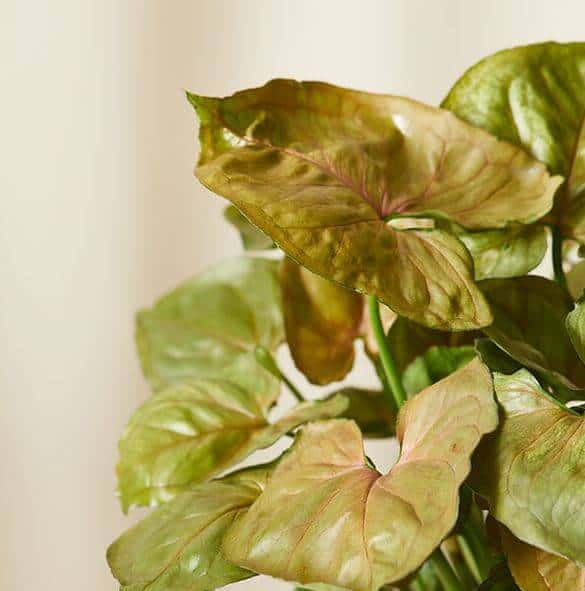Last Updated on May 28, 2023 by a Friendly Gardener
A beautiful, trailing vining plant, the Arrowhead is a rapid grower in the proper environmental conditions. A native of South America, it has increased in popularity as a houseplant due to its easy-care requirements. Botanically named the Syngonium podophyllum, the Arrowhead is a potentially lush houseplant to include in your indoor garden, but like all houseplants, if conditions are less than ideal, it will communicate that there is a problem.
Arrowhead Leaves Turning Yellow

The Arrowhead plant’s foliage can change to an undesirable yellow hue for a variety of reasons. Here are several of the more common motives than can easily be reversed to turn your plant into a healthy bundle of green.
Improper Watering and Moisture

Generally speaking, the number one reason for yellowing foliage on an Arrowhead plant is overwatering leading to an excess of moisture in the soil bed. These plants need to be watered only after at least 50% of the container soil is dry. Foliage will begin to wilt a bit to let you know it’s time for a drink.
When you do water your plant, make sure that both the soil and the container offer excellent drainage. If your plant’s pot has a dish underneath, excess water should be removed so that the plant isn’t sitting in water. The so-called “wet feet” of this plant are a leading cause of the development of root rot which can be fatal. Arrowhead plant yellow leaves are the first sign that your plant has potentially a problem with excess water.
Try to maintain a consistent watering habit. If you bounce back and forth between soggy soil and bone-dry soil, you will stress your plant causing the foliage to yellow.
Underwatering can also be the cause of yellow leaves particularly if they appear dry and feel crispy to the touch. If you forget to water your plant repeatedly, it will weaken and begin to dry out, eventually becoming limp. If you have doubts about the proper amount of moisture, use a moisture meter, or try lifting to judge the weight of the plant as pots containing moisture will be heavier. If underwatering is the problem, water a little bit for several days to avoid traumatizing your Arrowhead. After three or four days, give your plant a good soaking and allow it to drain out excess water completely.
Improper Humidity Level
Airhead plants will suffer in dry air. If the humidity is too low in the area where your plant is located, this together with underwatering can be the cause of arrowhead plant leaves turning yellow and brown. Leaves may eventually shrivel up and die.
Ensure that your plant has sufficient humidity by using a space humidifier in the area where your indoor plants are or placing a pebble tray underneath the container. You can also improve humidity somewhat by misting regularly and by grouping plants together to create a microclimate. Beware of air conditioning and heating units and vents near your plant and of dry air during the seasons when these units are in use.
Improper Light Exposure

The Arrowhead plant thrives in bright indirect light when cultivated indoors. This is not a plant that should be exposed to direct sunlight as leaves may scorch. With excessive light, yellow patches will appear on leaves, and sadly, these patches are not reversible.
This plant can adapt to lower light environments but will slow its growth as a result. However, should lighting be insufficient, yellow leaves may develop.
Lack of Nutrients
Yellowing leaves can also be indicative of nutrient deficiency. If your plant hasn’t been repotted for more than a year and you do not feed your plant during the growing season.
Consider repotting and make it a point to feed your arrowhead plant monthly during the spring and summer months. Dilute a liquid houseplant fertilizer to about half-strength before application.
Pest Infestations
If your plant is stressed by improper environmental conditions, it will be more susceptible to pest infestations that are typical of houseplants. Common houseplant pests include sap-sucking creatures such as spider mites. Sapsuckers will drain the Arrowhead plant of its juices and foliage will quickly turn yellow. Other pests to watch for include mealybugs and scales that frequently attack indoor plants. If these pests are not eliminated early and quickly, they will proliferate and infest the entire plant. Pest attacks will cause leaves to yellow as they are drained of juices.
If you note webbing under leaves (spider mites), white cottony deposits (mealybugs), or brown waxy deposits (scales), remove pests manually if possible and give your plant a shower remembering to allow it to drain adequately. Afterward, treat your plant with insecticidal soap or with a natural insecticide such as Neem oil that will not harm humans or pets.
Temperature Fluctuations
Arrowheads are at home in tropical and subtropical habitats, so they prefer a warm environment. They will be sensitive to any environmental temperatures of 50°F or lower. Cold temps will stress the plant and cause it to develop yellow leaves. Ideally, temps should measure between 60° and 85°F. Sudden temperature changes of any type will be stressful.
Natural Normal Aging

While we develop wrinkles, our plants may be developing yellow leaves. If your Arrowhead plant is showing new growth together with yellowing foliage, the yellow leaves may simply be older and the yellowing a natural phenomenon. Yellowing leaves due to aging usually develop very slowly and are usually limited to one or two leaves every couple of months.
This is especially true if they develop at the base or lower part of the plant. Older foliage is generally shed by plants so that energy can be channeled to new growth. If this is the reason for yellow foliage, simply trim these leaves off to help your plant in its natural development.
A Final Consideration

If your plant has developed yellow leaves, prune these off. This will improve the plant’s appearance and save the plant’s energy from being channeled to dead or dying foliage.


